-
ARTÍCULO ORIGINAL16/12/2024
Editorial discourses in the history of Acta Paulista de Enfermagem (1988-2017)
Revista Brasileira de Enfermagem. 2024;77(6):e20230362
Resumen
ARTÍCULO ORIGINALEditorial discourses in the history of Acta Paulista de Enfermagem (1988-2017)
Revista Brasileira de Enfermagem. 2024;77(6):e20230362
DOI 10.1590/0034-7167-2023-0362
Visualizações0Ver maisABSTRACT
Objectives:
to analyze the editorial discourses of Acta Paulista de Enfermagem from 1988 to 2017.
Methods:
qualitative, historical, oral research, with interviews with the journal’s editors. Statements were categorized and presented in three decades, discussed from Foucault’s archaeological perspective.
Results:
seven statements presented three discourses. In the first decade, the discourse of knowledge registration and circulation presented statements of graduate studies and professional recognition. In the second decade, knowledge internationalization was added, with statements of business and editorial panopticism, selection criteria, indexing and digitalization. Finally, the discourse of shifting scientific assessment centrality was added with statements of preprint, open science, exclusive digitalization and mediatization of science.
Final Considerations:
the journal needed to adapt to form its official discourse, which made it possible, over the years, to change its initial peripheral position to a central one within scientific communication, supporting its panoptic role.
-
ARTÍCULO DE REVISIÓN16/12/2024
Strategies for expanding vaccination coverage in children in Brazil: systematic literature review
Revista Brasileira de Enfermagem. 2024;77(6):e20230343
Resumen
ARTÍCULO DE REVISIÓNStrategies for expanding vaccination coverage in children in Brazil: systematic literature review
Revista Brasileira de Enfermagem. 2024;77(6):e20230343
DOI 10.1590/0034-7167-2023-0343
Visualizações1Ver maisABSTRACT
Objectives:
to identify the strategies found in the literature for increasing vaccination coverage among children in Brazil. It is justified mainly by the current scenario of falling vaccination coverage.
Methods:
systematic literature review. The search was carried out in the Pubmed (MEDLINE), Embase and Scopus databases, following the PRISMA guidelines.
Results:
initially, 4,824 results were returned. In the end, 6 studies were included for narrative synthesis using the SWiM methodology. Of these, 50% dealt with studies related to the Bolsa Família Program (PBF). The others explored strategies for approaching parents directly, Rapid Vaccination Monitoring (MRV) and the Community Health Agents Program (PACS). The PBF did not guarantee compliance with the conditionality of keeping vaccinations up to date. The MRV and PACS are effective strategies, especially because they allow active search for absentees.
Conclusions:
we conclude that more publications are needed on strategies to increase vaccination coverage among children in Brazil.

-
ARTÍCULO ORIGINAL16/12/2024
Educational technology to empower patients as participants in their care
Revista Brasileira de Enfermagem. 2024;77(6):e20230359
Resumen
ARTÍCULO ORIGINALEducational technology to empower patients as participants in their care
Revista Brasileira de Enfermagem. 2024;77(6):e20230359
DOI 10.1590/0034-7167-2023-0359
Visualizações0Ver maisABSTRACT
Objectives:
to build and validate an educational technology to empower patients as participants in their own care.
Methods:
methodological study to develop an educational technology based on the elaboration, validation, and evaluation that were carried out in five stages at a teaching hospital in Amazonas. The study was carried out from 2019 to 2022, with the participation of 19 judges specialized in patient safety and 72 patients admitted to the hospital’s medical and surgical clinics, the study setting.
Results:
the agreement between the judges obtained an overall index of 0.85, being considered validated. The overall analysis of the booklet obtained an assessment of the level of agreement above 85%.
Final Considerations:
the educational technology presented here was validated and suitable for promoting patient/professional rapprochement and consolidating health care in a way that increases the patient’s ability to contribute to their treatment and prevent the occurrence of adverse events.
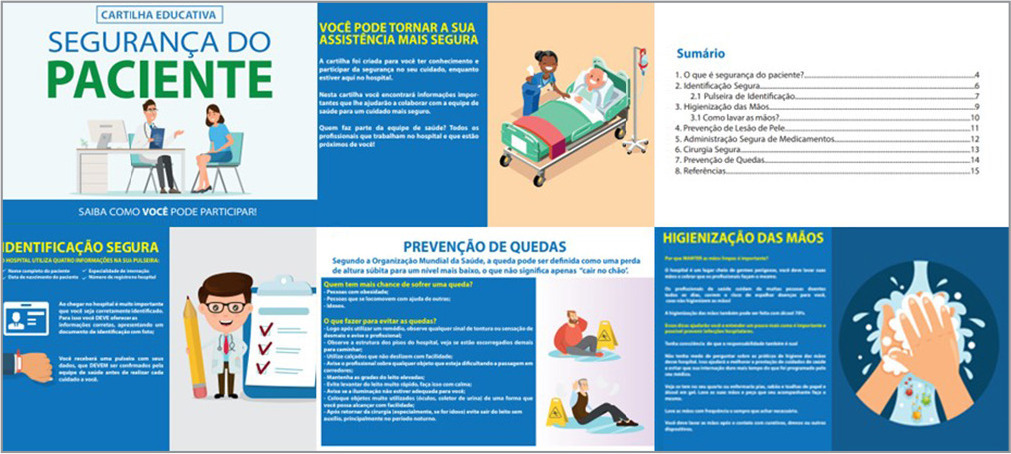
-
ARTÍCULO ORIGINAL13/12/2024
Educational booklet on labor and delivery: validity study
Revista Brasileira de Enfermagem. 2024;77(5):e20240138
Resumen
ARTÍCULO ORIGINALEducational booklet on labor and delivery: validity study
Revista Brasileira de Enfermagem. 2024;77(5):e20240138
DOI 10.1590/0034-7167-2024-0138
Visualizações2Ver maisABSTRACT
Objectives:
to develop and validate an educational booklet on labor and delivery for pregnant women.
Methods:
this methodological study involved constructing and validating a booklet based on Echer’s framework. We used the Content Validity Index and Cronbach’s alpha for content and face validation, selecting judges according to Fering’s criteria. We then conducted a clinical validation with the target population.
Results:
the booklet, developed based on evidence from an integrative review and validated by judges and the target audience, achieved global Content Validity Index of 0.919 and 0.913, respectively. After clinical validation with 22 pregnant women, it included 28 topics and 48 pages, with illustrations by a graphic designer.
Conclusions:
expert judges and the target audience considered this educational technology valid, deeming it a relevant tool for promoting the health of pregnant women.
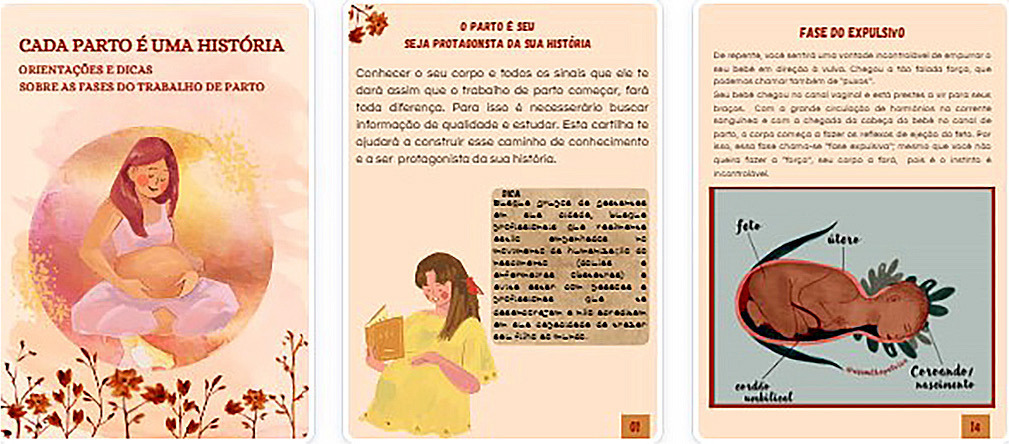
-
ARTÍCULO ORIGINAL13/12/2024
Interobserver agreement in Reception and Risk Stratification in Obstetrics implementation
Revista Brasileira de Enfermagem. 2024;77(5):e20230361
Resumen
ARTÍCULO ORIGINALInterobserver agreement in Reception and Risk Stratification in Obstetrics implementation
Revista Brasileira de Enfermagem. 2024;77(5):e20230361
DOI 10.1590/0034-7167-2023-0361
Visualizações0Ver maisABSTRACT
Objectives:
to analyze interobserver agreement in the Reception and Risk Stratification in Obstetrics protocol implementation.
Methods:
a cross-sectional study carried out during Reception and Risk Stratification in Obstetrics implementation, conducted in a tertiary hospital in southern Brazil with 891 participants in January 2020. Descriptive and interobserver agreement analysis was carried out using the Kappa coefficient in the risk stratification assigned by the triage nurse and reviewed by the researcher.
Results:
around half of the calls (55.6%) were stratified as not very urgent (green), followed by urgent (yellow) (31.8%), very urgent (orange) (9.3%), not urgent (blue) (3.4%) and no emerging stratification (red). Agreement analysis of revised stratification found Kappa values of 0.20 (blue), 0.54 (green), 0.77 (yellow) and 0.80 (orange).
Conclusions:
most appointments were non-urgent. The agreement analysis between the revised and assigned risk stratification revealed greater interobserver agreement as the priority level increased.
-
13/12/2024
Training of Brazilian indigenous nurses: between human rights, valuing diversity and inclusion
Revista Brasileira de Enfermagem. 2024;77(5):e20230430
Resumen
Training of Brazilian indigenous nurses: between human rights, valuing diversity and inclusion
Revista Brasileira de Enfermagem. 2024;77(5):e20230430
DOI 10.1590/0034-7167-2023-0430
Visualizações0Ver maisABSTRACT
Objectives:
to analyze the possibilities and potential of training indigenous nurses, given the Brazilian Health System (SUS), understanding the relationships between education and health.
Methods:
theoretical-reflective study, based on scientific literature, aligned with the experience, critical thinking of its authors and the Sustainable Development Goals in Brazil.
Results:
this text articulates three axes: Potential for including indigenous students in nursing training; Paths to achieving equity through inclusion and retention policies for indigenous students at different levels; and Implications of this for the SUS and global health.
Final Considerations:
indigenous students, beneficiaries of affirmative actions, face challenges of inclusion and retention in public universities that directly impact their academic training. Added to this are the difficulties identified in basic education, professor training and implementation of permanence policies, with consequences for services and training at other levels.
-
ARTÍCULO ORIGINAL13/12/2024
Stress in nursing workers caring for people with COVID-19
Revista Brasileira de Enfermagem. 2024;77(5):e20230542
Resumen
ARTÍCULO ORIGINALStress in nursing workers caring for people with COVID-19
Revista Brasileira de Enfermagem. 2024;77(5):e20230542
DOI 10.1590/0034-7167-2023-0542
Visualizações1Ver maisABSTRACT
Objectives:
to analyze stress from the perspective of nursing workers caring for people with COVID-19 in a public hospital in the Recôncavo region of Bahia.
Methods:
this is an exploratory qualitative study, conducted through semi-structured interviews. The data were analyzed using word clouds, similarity trees, and content analysis.
Results:
nursing workers were exposed to stress while attending to patients with COVID-19. The reported stressors in the workplace included: work overload, lack of planning, speed in performing tasks, fatigue, lack of participation in decision-making, lack of support from management, technological changes, excessive responsibility without preparation, interpersonal conflicts, and professional undervaluation.
Conclusions:
exposure to these stressors leads to emotional exhaustion and demotivation, which were intensified during the COVID-19 pandemic.
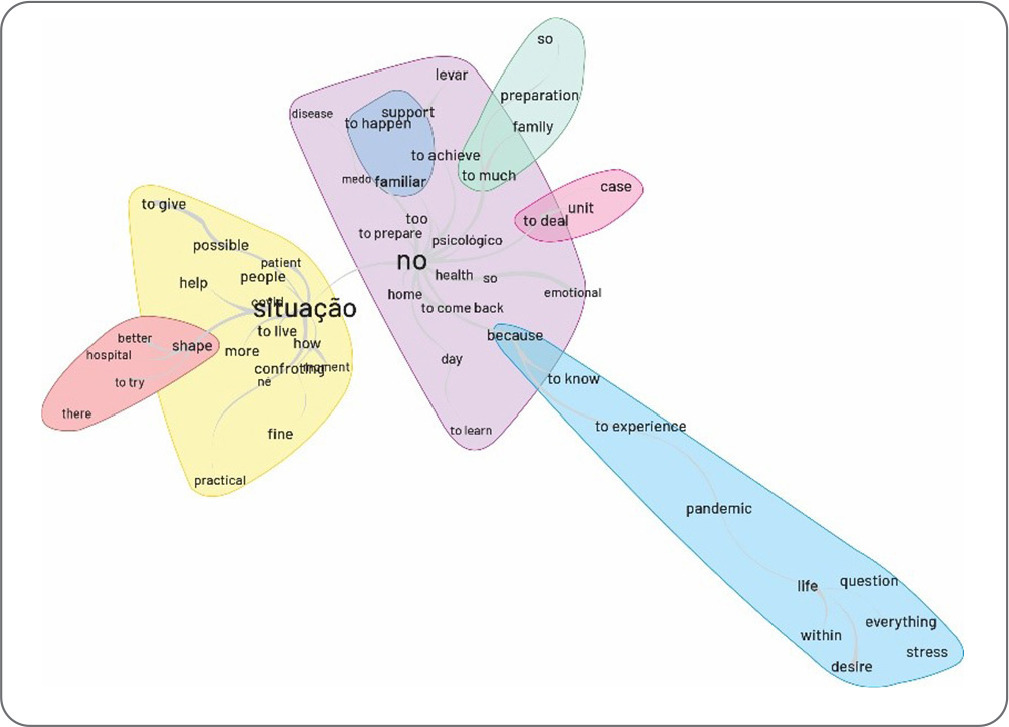
-
ARTÍCULO ORIGINAL13/12/2024
Adaptation and implementation of a Nursing care protocol for children in the Amazon Region
Revista Brasileira de Enfermagem. 2024;77(5):e20230245
Resumen
ARTÍCULO ORIGINALAdaptation and implementation of a Nursing care protocol for children in the Amazon Region
Revista Brasileira de Enfermagem. 2024;77(5):e20230245
DOI 10.1590/0034-7167-2023-0245
Visualizações0Ver maisABSTRACT
Objectives:
to describe the process of implementing an adapted protocol for pediatric nursing care in a health unit located in a municipality in the Amazon Region.
Methods:
methodological research conducted in a basic health unit with four family health teams in the state of Rondônia, involving seven nursing professionals. Data collection occurred between October 2020 and April 2022, following the research phases: situational diagnosis, exploratory phase, protocol definition, implementation, and evaluation.
Results:
the outcome was the adaptation and implementation of a nursing care protocol for children.
Final Considerations:
the adaptation and implementation process can be an effective approach to improving care, strengthening nursing as a profession with a solid foundation in scientific and clinical evidence. This facilitates early problem identification and appropriate guidance, leading to better health outcomes for children.
-
18/03/2024
Nursing rights in comics: educational technological innovation report
Revista Brasileira de Enfermagem. 2024;77:e20230438
Resumen
Nursing rights in comics: educational technological innovation report
Revista Brasileira de Enfermagem. 2024;77:e20230438
DOI 10.1590/0034-7167-2023-0438
Visualizações0Ver maisABSTRACT
Objectives:
to report an educational technology construction on nursing professionals’ rights.
Methods:
an experience report on educational technology construction during the crediting of university extension hours in an undergraduate nursing course at a Brazilian public university, between March and June 2023. The Deming cycle was used as a procedural method.
Results:
four meetings were held between students and extension workers. Eight comic books were produced based on the Code of Ethics for Nurses, addressing professional autonomy, fair remuneration, risk-free work, denial of exposure in the media and others. The Deming cycle proved to be an important strategy for constructing products.
Conclusions:
nursing professionals’ rights must be discussed and improved. Educational technologies, such as comic books, provide playful and reflective learning.
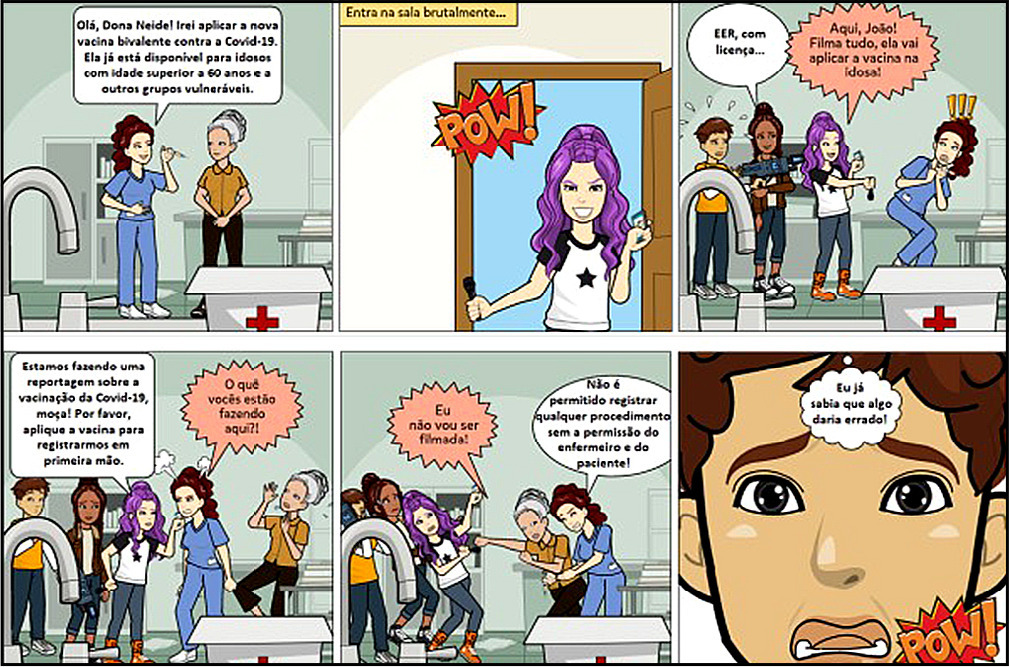
-
ARTÍCULO ORIGINAL10/01/2024
Nursing students and the internet: a reflection of digital ethics
Revista Brasileira de Enfermagem. 2024;77:e20230459
Resumen
ARTÍCULO ORIGINALNursing students and the internet: a reflection of digital ethics
Revista Brasileira de Enfermagem. 2024;77:e20230459
DOI 10.1590/0034-7167-2023-0459
Visualizações0Ver maisABSTRACT
Objectives:
to identify how first-year nursing students use cyberspace and propose an orientation guide with criteria guiding the use of cyberspace.
Methods:
qualitative and descriptive research, carried out with 24 nursing students from a federal public institution in Rio de Janeiro. Data collection was carried out through semi-structured interviews. Data analysis occurred using IRAMUTEQ®. The research was approved by the institution’s Research Ethics Committee.
Results:
students use cyberspace to communicate, study, find “cool things”, share photos and memories. Furthermore, they are concerned about hate speech, intolerance and fake news. The good and bad sides and the types of technologies most used were also portrayed.
Final considerations:
the moral and ethical values of physical coexistence, together with awareness of individual responsibility, are the pillars for using cyberspace. The guide comes as an awareness tool.
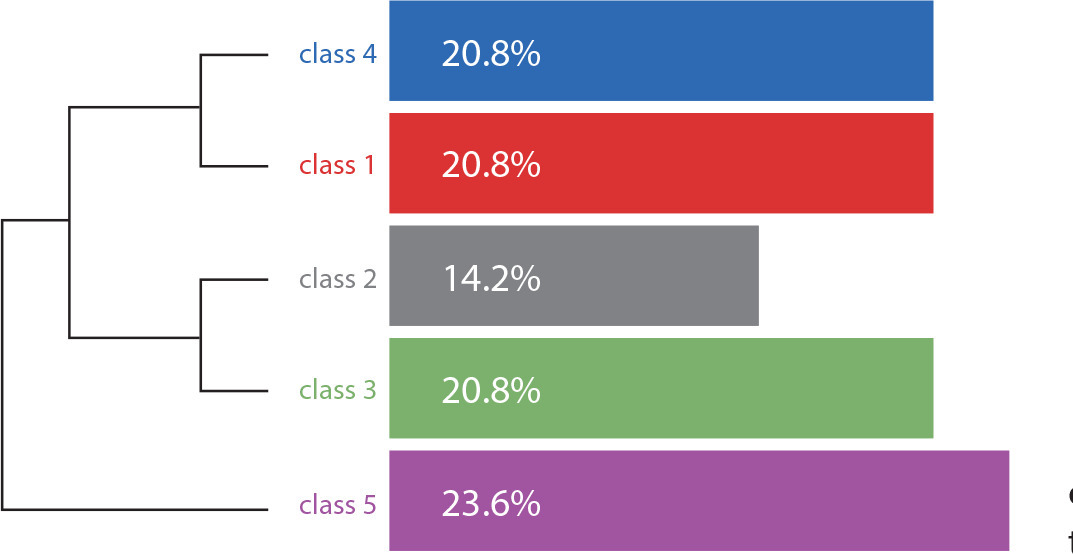
-
03/03/2021
Análise de conceito da Sede Perioperatória para o desenvolvimento de um novo diagnóstico de enfermagem
Revista Brasileira de Enfermagem. 2021;74(1):e20200065
Resumen
Análise de conceito da Sede Perioperatória para o desenvolvimento de um novo diagnóstico de enfermagem
Revista Brasileira de Enfermagem. 2021;74(1):e20200065
DOI 10.1590/0034-7167-2020-0065
Visualizações0RESUMO
Objetivos:
analisar o conceito de sede perioperatória para o desenvolvimento de uma nova estrutura diagnóstica segundo a NANDA Internacional.
Métodos:
estudo de análise de conceito baseado no referencial proposto por Walker e Avant, instrumentalizada por meio de uma revisão integrativa da literatura nas bases SCOPUS, CINAHL, PUBMED, LILACS e WOS. A elaboração da estrutura diagnóstica seguiu as diretrizes da NANDA Internacional.
Resultados:
foram analisados 41 estudos revelando que a sede perioperatória é prevalente e intensa, tendo como núcleo do conceito atributos viscerais e comportamentais. Antecedentes indicam que o paciente cirúrgico é vulnerável à sede, e como consequentes, 16 sinais e sintomas foram organizados e casos modelo foram desenvolvidos. Foi desenvolvido uma estrutura diagnóstica para a sede perioperatória.
Considerações Finais:
a análise de conceito permitiu a padronização da linguagem que descreve o paciente com sede, auxiliando a identificação, planejamento de ações e comunicação da assistência de enfermagem perioperatória.
Palavras-chave: Assistência PerioperatóriaDiagnóstico de EnfermagemFormação de ConceitoSedeTerminologia Padronizada em EnfermagemVer mais
-
14/04/2021
Fatores associados à ansiedade em residentes multiprofissionais em saúde durante a pandemia por COVID-19
Revista Brasileira de Enfermagem. 2021;74:e20200961
Resumen
Fatores associados à ansiedade em residentes multiprofissionais em saúde durante a pandemia por COVID-19
Revista Brasileira de Enfermagem. 2021;74:e20200961
DOI 10.1590/0034-7167-2020-0961
Visualizações0RESUMO
Objetivo:
Estimar a prevalência e os fatores associados à ansiedade entre residentes multiprofissionais em saúde durante a pandemia da COVID-19.
Métodos:
Estudo transversal, realizado em julho de 2020 com residentes multiprofissionais em saúde (n = 67) de um hospital universitário. Utilizou-se a Beck Anxiety Inventory para avaliação da ansiedade. Analisaram-se os dados usando teste qui-quadrado, razão de verossimilhança e análise múltipla mediante regressão de Poisson com variância robusta.
Resultados:
A proporção de ansiedade moderada/grave foi de 31,30%, que apresentou associação significante com trabalhar em setores envolvendo COVID-19 e diretamente com casos suspeitos/confirmados de COVID-19. Na análise múltipla, observou-se prevalência de ansiedade nos participantes que precisaram de acompanhamento psicológico após entrada na residência e que usavam psicotrópicos.
Conclusão:
Os resultados parecem indicar que os residentes tiveram sua saúde mental prejudicada durante a pandemia, porém a manutenção das variáveis no modelo também sugere que buscaram ajuda para o controle da ansiedade.
Palavras-chave: AnsiedadeHospitais UniversitáriosInfecções por CoronavirusInternato e ResidênciaPandemiaVer mais -
REFLEXIÓN05/02/2021
Empathic listening: welcoming strategy for nursing Professional in coping with with the coronavirus pandemic
Revista Brasileira de Enfermagem. 2021;74:e20200721
Resumen
REFLEXIÓNEmpathic listening: welcoming strategy for nursing Professional in coping with with the coronavirus pandemic
Revista Brasileira de Enfermagem. 2021;74:e20200721
DOI 10.1590/0034-7167-2020-0721
Visualizações0Ver maisABSTRACT
Objective:
to reflect on empathic listening use as a welcoming strategy for nursing professionals to cope with the challenges during the pandemic caused by the new coronavirus.
Methods:
this is a reflection study based on updated data surveys and theoretical-conceptual aspects of Non-Violent Communication and empathic listening.
Results:
in the performance during the COVID-19 pandemic, nursing professionals are exposed to violence of different natures related to occupational stress, work overload, anguishes and silenced suffering, with implications for the workers’ health, who can be benefited and strengthened with empathetic listening.
Final considerations:
the health crisis has highlighted the weaknesses of the health system. Nursing acts as the largest contingent of the health workforce in coping with the pandemic. Empathetic listening is a powerful strategy in caring for and strengthening nursing professionals.
-
ARTÍCULO ORIGINAL07/09/2020
Creation and validation of a visual educational technology content for lactation physiology learning
Revista Brasileira de Enfermagem. 2020;73(6):e20190564
Resumen
ARTÍCULO ORIGINALCreation and validation of a visual educational technology content for lactation physiology learning
Revista Brasileira de Enfermagem. 2020;73(6):e20190564
DOI 10.1590/0034-7167-2019-0564
Visualizações0Ver maisABSTRACT
Objective:
to create and validate a visual educational technology content for lactation physiology learning.
Method:
a methodological study that contemplated the stages of content creation and validation guided by the conceptual model of Knowledge Translation into action. The creation took place in partnership with the educational technology center of the project’s home institution. The validation was attended by 27 judges with experience in the obstetric, neonatal, pediatric or maternal and child areas and in the theme of breastfeeding.
Results:
an educational technology covered animation and video techniques to locate, respectively, elements of lactation physiology and the population involved. An Overall Content Validity Index of 0.84 was obtained.
Conclusion:
the visual educational technology for lactation physiology learning has been validated in content as a tool to introduce the theme and mediate health education actions that can have a positive impact on breastfeeding.
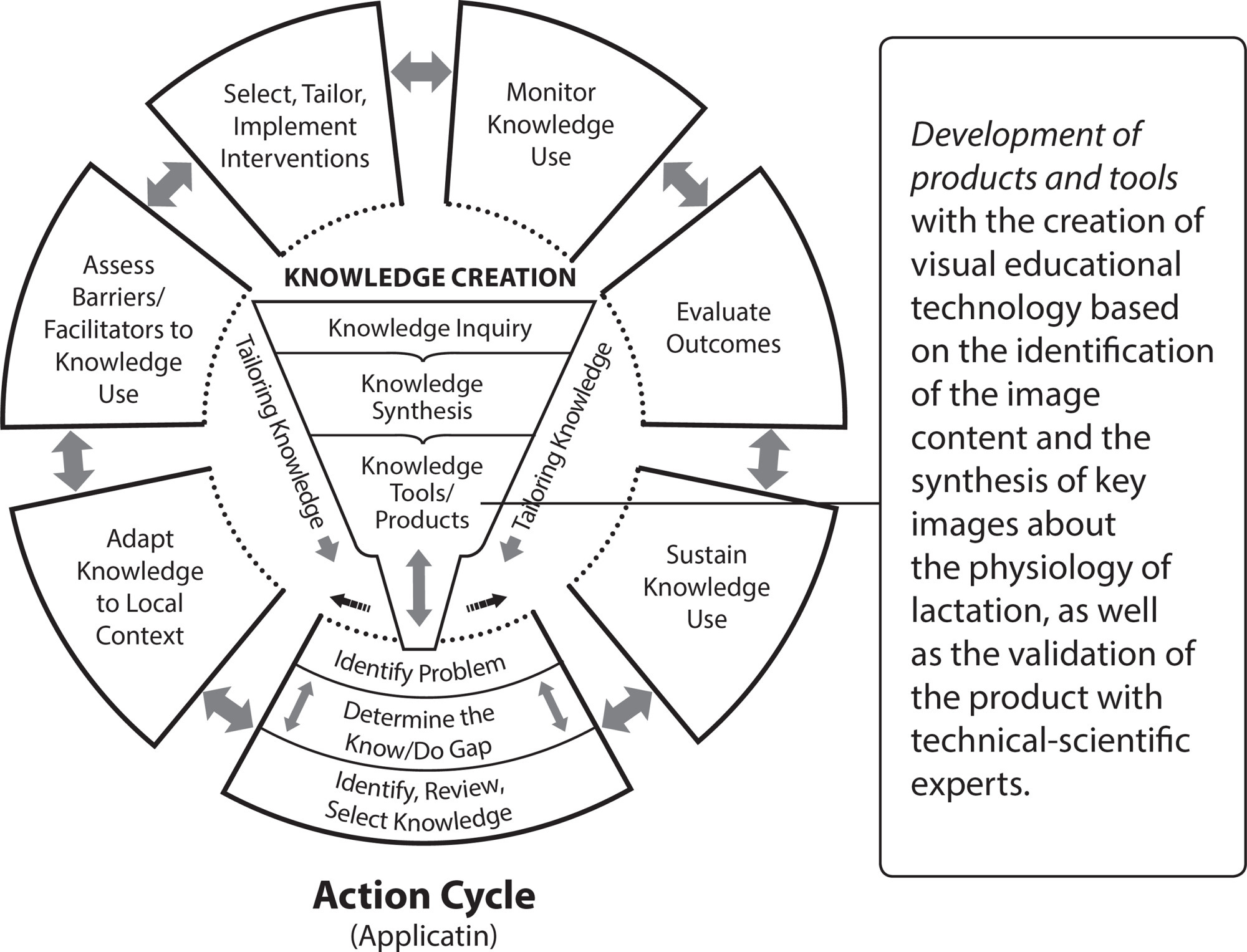
-
ARTÍCULO DE REVISIÓN13/12/2019
O uso de histórias infantis no cuidado de enfermagem à criança: revisão integrativa
Revista Brasileira de Enfermagem. 2019;72:333-342
Resumen
ARTÍCULO DE REVISIÓNO uso de histórias infantis no cuidado de enfermagem à criança: revisão integrativa
Revista Brasileira de Enfermagem. 2019;72:333-342
DOI 10.1590/0034-7167-2018-0456
Visualizações0Ver maisRESUMO
Objetivo:
Identificar como as histórias infantis podem ser utilizadas no cuidado à criança.
Método:
Revisão integrativa da literatura, realizada em bases de dados, entre 2000 e 2018, em três idiomas. Foram incluídos artigos de pesquisa disponíveis na íntegra e que estavam de acordo com a seguinte questão: “Como as histórias infantis podem ser utilizadas no cuidado à criança?”.
Resultados:
A partir da análise de 16 artigos selecionados, emergiram três categorias: O uso de histórias no hospital; Intervenção de enfermagem especializada; e Histórias na dimensão educativa.
Considerações finais:
As evidências apontam benefícios às crianças, às famílias, às instituições e à Enfermagem. O uso de histórias infantis como intervenção de cuidado pode ocorrer em diferentes situações e cenários, valoriza e estimula vínculos, reduz ansiedade das crianças e familiares, estimula a participação das crianças no cuidado, e promove educação em saúde. É uma estratégia de baixo custo e ainda incipiente na Enfermagem.
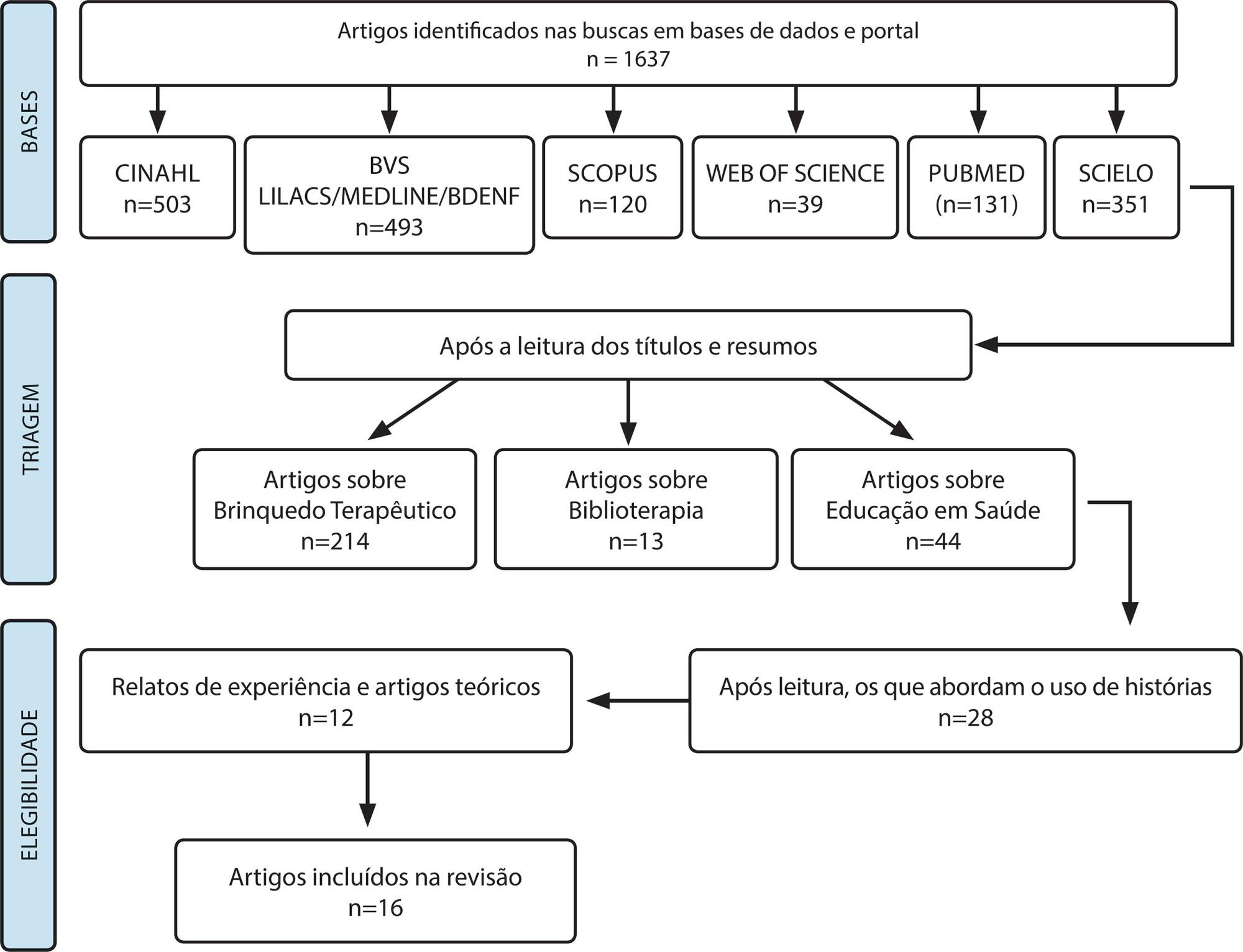
-
ARTÍCULO ORIGINAL19/10/2020
Fatores associados ao risco de suicídio entre enfermeiros e médicos: estudo transversal
Revista Brasileira de Enfermagem. 2020;73:e20200352
Resumen
ARTÍCULO ORIGINALFatores associados ao risco de suicídio entre enfermeiros e médicos: estudo transversal
Revista Brasileira de Enfermagem. 2020;73:e20200352
DOI 10.1590/0034-7167-2020-0352
Visualizações0Ver maisRESUMO
Objetivo:
estimar a prevalência e os fatores associados ao risco de suicídio entre enfermeiros e médicos.
Método:
estudo transversal, desenvolvido em um hospital universitário com 216 profissionais da saúde, que responderam a um questionário sociodemográfico-laboral; ao Mini International Neuropsychiatric Interview (MINI), para avaliação do risco de suicídio; Escala de Depressão, Ansiedade e Estresse (DASS 21). Utilizou-se para análise múltipla, o Modelo de Regressão de Poisson.
Resultados:
identificou-se que variáveis, como não ter companheiro, histórico de tentativa de suicídio, sintomas de estresse e depressão se associaram estatisticamente ao risco de suicídio. A prevalência das tentativas de suicídios ao longo da vida entre enfermeiros foi de 9,41% e médicos de 2,29%.
Conclusão:
Os achados desta investigação possibilitam a compreensão do comportamento suicida entre os enfermeiros e médicos da área hospitalar, além de viabilizar a elaboração de estratégias de prevenção com intuito de diminuir a prevalência do risco de suicídio nesse grupo populacional.
-
ARTÍCULO ORIGINAL17/06/2020
Fatores de risco cardiovascular: diferenças entre grupos étnicos
Revista Brasileira de Enfermagem. 2020;73(4):e20180918
Resumen
ARTÍCULO ORIGINALFatores de risco cardiovascular: diferenças entre grupos étnicos
Revista Brasileira de Enfermagem. 2020;73(4):e20180918
DOI 10.1590/0034-7167-2018-0918
Visualizações0Ver maisRESUMO
Objetivos:
comparar os indicadores metabólicos, antropométricos, de consumo de tabaco e álcool, considerados como fatores de risco para doenças cardiovasculares, assim como as características demográficas e socioeconômicas entre indígenas do Rio Negro, Sateré-Mawé, Pardos/Negros e Brancos que residem na cidade de Manaus.
Métodos:
estudo observacional transversal, norteado pela ferramenta STROBE. Amostra de 191 adultos de ambos os sexos. Realizadas medidas antropométricas, pressão arterial e análises bioquímicas. Aplicado teste estatístico no cruzamento da variável cor/raça/etnia com as variáveis investigadas.
Resultados:
os indígenas apresentaram melhores indicadores metabólicos e antropométricos relacionados às doenças cardiovasculares que os pardos/negros e brancos, assim como os Sateré-Mawé em relação aos rionegrinos.
Conclusões:
as principais diferenças foram: obesidade, dislipidemia, pré-hipertensão arterial sistêmica/hipertensão arterial sistêmica e circunferências aumentadas, com destaque de pior situação para os pardos/negros. Os achados indicam haver diferenças nos fatores de risco entre os grupos de raça/cor e etnia avaliados.
-
INFORME DE EXPERIENCIA03/04/2020
Use of webQDA software on qualitative nursing research: an experience report
Revista Brasileira de Enfermagem. 2020;73(3):e20180411
Resumen
INFORME DE EXPERIENCIAUse of webQDA software on qualitative nursing research: an experience report
Revista Brasileira de Enfermagem. 2020;73(3):e20180411
DOI 10.1590/0034-7167-2018-0411
Visualizações0Ver maisABSTRACT
Objectives:
to report the user experience of the webQDA software in the support of qualitative data analysis about health literacy of older adults.
Methods:
quasi-experimental research developed from January 2014 to January 2015, with 118 older adults, all of whom were interviewed to assess the level of health literacy. Interviews were carried out before and after four educational interventions, according to Freire’s method named Culture Circle. The interviews were transcribed and entered in the software, which highlighted the analytical categories.
Results:
the systems of sources, interpretative encoding and questioning of the data available in the software allowed the construction of three categories for the literacy levels and four categories for their dimensions.
Final considerations:
We concluded that the webQDA software enables the structured encoding of qualitative materials, ensuring faster and effective management of data with systematization and analytical transparency.
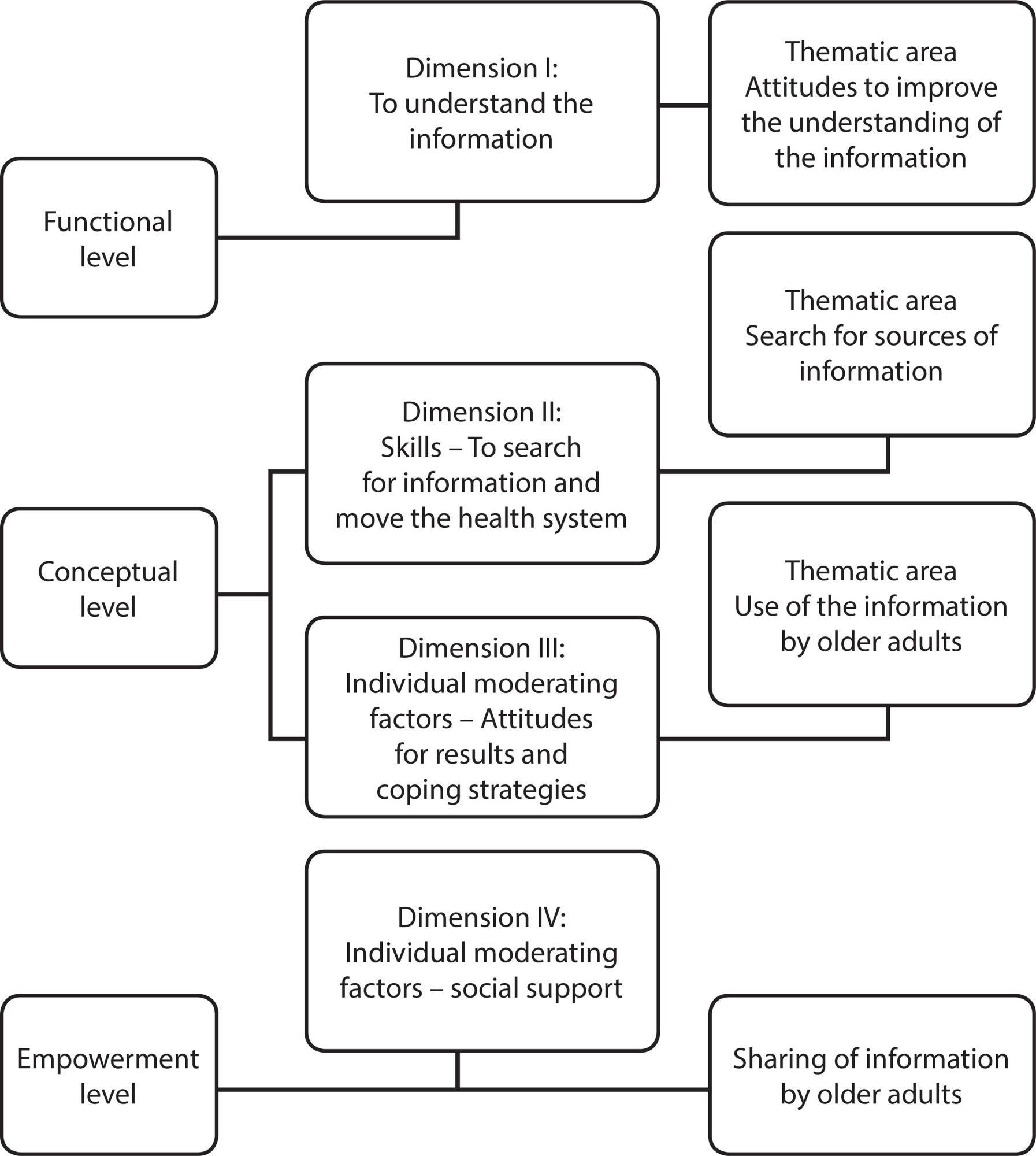
Búsqueda
Buscar en:
Nuvem de Tags
Adolescente (85) Atenção Primária à Saúde (239) COVID-19 (91) Criança (91) Cuidados de Enfermagem (269) Educação em Enfermagem (151) Educação em Saúde (139) Enfermagem (930) Enfermagem Pediátrica (86) Estudantes de Enfermagem (77) Estudos de Validação (131) Família (87) Idoso (208) Promoção da Saúde (99) Qualidade de Vida (104) Saúde do Trabalhador (86) Saúde Mental (145) Saúde Pública (82) Segurança do Paciente (150) Tecnologia Educacional (100)



